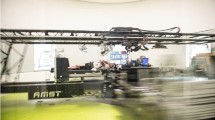Abstract
Background and purpose
Orthostatic intolerance continues to be a problem with astronauts upon return to Earth as a result of cerebral and cardiovascular adaptations to weightlessness. We tested the hypothesis that artificial gravity from a short-arm human centrifuge (SAHC) could provide cerebral and cardiovascular stimuli similar to upright posture and thereby serve as a suitable countermeasure.
Methods
We compared cardiovascular and cerebrovascular responses before, during, and after exposure to hyper-G with that of standing in healthy young participants. The head was positioned such that the middle cerebral artery (MCA) was 0.46 m from the center of rotation. Two levels of hyper-G that provided 1g and 2g at foot level were investigated. Continuous blood pressure, heart rate, calf blood volume, MCA mean blood flow velocity (MFV) and end-tidal CO2 were measured.
Results
Blood pressure at the level of the MCA (BP-MCA) and MFV was reduced during stand and at 2g. The relationship between MFV and BP-MCA at 2g was different from supine and similar to standing, while 1g centrifugation was not different from supine. The cardiovascular system was also not different from supine at 1g but was similarly challenged in 2g compared to stand.
Conclusions
Our data suggest that short-arm centrifugation 2g at the feet, with the head offset 0.5 m from the center, provides similar cardiovascular and cerebral responses to standing. This supports the hypothesis that passive 2g SAHC exposure at the feet could be used as a countermeasure for in-flight cardiovascular and cerebrovascular deconditioning.


Similar content being viewed by others
References
Blaber AP, Goswami N, Bondar RL, Kassam MS (2011) Impairment of cerebral blood flow regulation in astronauts with orthostatic intolerance after flight. Stroke 42:1844–1850
Blaber AP, Hinghofer-Szalkay H, Goswami N (2013a) Blood volume redistribution during hypovolemia. Aviat Space Environ Med 84:59–64, 1844–1850
Blaber A, Zuj K, Goswami N (2013b) Space physiology III: cerebrovascular autoregulation: lessons learned from space flight research. Eur J Appl Physiol 113:1909–1917
Evans JM, Stenger MB, Moore FB, Hinghofer-Szalkay H, Rössler A, Patwardhan AR, Brown DR, Ziegler MG, Knapp CF (2004) Centrifuge training increases presyncopal orthostatic tolerance in ambulatory men. Aviat Space Environ Med 75:850–858
Fogarty JA, Otto C, Kerstman E, Oubre C, Wu J (2011) The visual impairment intracranial pressure summit report. NASA Johnson Space Center, Houston
Fritsch-Yelle JM, Charles JB, Jones MM, Beightol LA, Eckberg DL (1994) Spaceflight alters autonomic regulation of arterial pressure in humans. J Appl Physiol 77:1776–1783
Gisolf J, Immink RV, Van Lieshout JJ, Stok WJ, Karemaker JM (2005) Orthostatic blood pressure control before and after spaceflight, determined by time-domain baroreflex method. J Appl Physiol 98:1682–1690
Goswami N, Batzel JJ, Clément G, Stein TP, Hargens AR, Sharp MK, Blaber AP, Roma PG, Hinghofer-Szalkay HG (2013) Maximizing information from space data resources: a case for expanding integration across research disciplines. Eur J Appl Physiol 113:1645–1654
Hachiya T, Blaber AP, Saito M (2004) Changes in thigh superficial blood distribution during LBNP assessed by NIRS. Aviat Space Environ Med 75:118–122
Hachiya T, Blaber AP, Saito M (2008) Near-infrared spectroscopy provides an index of blood flow and vasoconstriction during LBNP. Acta Physiol 193:117–127
Hughson RL, Shoemaker JK, Blaber AP, Arbeille P, Greaves DK, Pereira PP Jr, Xu D (2012) Cardiovascular regulation during long-duration spaceflights to the International Space Station. J Appl Physiol 112:719–727
Iwase S, Fu Q, Narita K, Morimoto E, Takada H, Mano T (2002) Effects of graded load of artificial gravity on cardiovascular functions in humans. Environ Med 46:29–32
Mader TH, Gibson CR, Pass AF, Kramer LA, Lee AG, Fogarty J, Tarver WJ, Dervay JP, Hamilton DR, Sargsyan A, Phillips JL, Tran D, Lipsky W, Choi J, Stern C, Kuyumjian R (2011) Optic disc edema, globe flattening, choroidal folds, and hyperopic shifts observed in astronauts after long-duration space flight. Ophthalmology 118:2058–2069
Mano T (2005) Autonomic neural functions in space. Curr Pharm Biotechnol 6:319–324
Parlow J, Viale JP, Annat G, Hughson R, Quintin L (1995) Spontaneous cardiac baroreflex in humans: comparison with drug-induced responses. Hypertension 25:1058–1068
Stenger MB, Evans JM, Knapp CF, Lee SM, Phillips TR, Perez SA, Moore AD Jr, Paloski WH, Platts SH (2012) Artificial gravity training reduces bed rest-induced cardiovascular deconditioning. Eur J Appl Physiol 112:605–616
Verheyden B, Beckers F, Couckuyt K, Liu J, Aubert AE (2007) Respiratory modulation of cardiovascular rhythms before and after short-duration human spaceflight. Acta Physiol (Oxf) 191:297–308
Verheyden B, Liu J, Beckers F, Aubert AE (2010) Operational point of neural cardiovascular regulation in humans up to 6 months in space. J Appl Physiol 108:646–654
Watenpaugh DE, Hargens AR (1996) The cardiovascular system in microgravity. In: Fregly MJ, Blatteis CM (eds) Handbook of physiology: environmental physiology, vol I. Oxford University Press, New York, pp 631–674
Zhang LF, Hargens AR (2014) Intraocular/intracranial pressure mismatch hypothesis for visual impairment syndrome in space. Aviat Space Environ Med 85:78–80
Zuj KA, Arbeille P, Shoemaker JK, Blaber AP, Greaves DK, Xu D, Hughson RL (2012) Impaired cerebrovascular autoregulation and reduced CO2 reactivity after long duration spaceflight. Am J Physiol Heart Circ Physiol 302(12):H2592–H2598
Acknowledgments
We wish to thank the participants for their time and co-operation. The European Space Agency’s CORA-GBF program supported this study.
Author information
Authors and Affiliations
Corresponding author
Additional information
Communicated by Guido Ferretti.
Rights and permissions
About this article
Cite this article
Goswami, N., Bruner, M., Xu, D. et al. Short-arm human centrifugation with 0.4g at eye and 0.75g at heart level provides similar cerebrovascular and cardiovascular responses to standing. Eur J Appl Physiol 115, 1569–1575 (2015). https://doi.org/10.1007/s00421-015-3142-8
Received:
Accepted:
Published:
Issue Date:
DOI: https://doi.org/10.1007/s00421-015-3142-8




